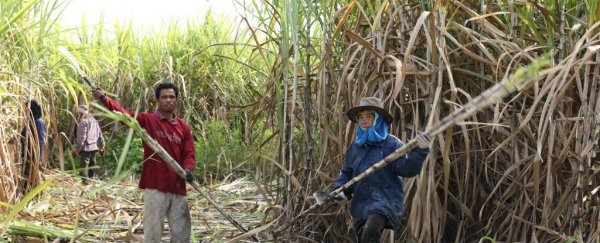If you're a fan of sugar - and let's face it, you probably are - 2016 is going to be an expensive year, because recent El Niño events have brought on a worldwide sugar shortage that's becoming a whole lot bigger than analysts initially thought.
According to a report by The Independent, raw sugar prices are up 45 percent since last August, and researchers say it's because El Niño has dealt a one-two punch to the areas of the world where most sugar is produced. For India, Thailand, and China, droughts have devastated this year's production, and will likely affect next year's yield as well.
The world's second largest sugar-producing region, India, has experienced decreased rainfall that has limited the number of crops farmers were able to plant. To make matters worse, the areas that have received rain, such as Brazil, got too much to properly harvest cane.
All of this means that there isn't enough sugar to fulfil the 4.95 million tonnes the world is expected to consume this year. Demand for the natural sweetener is expected to exceed new supply by 7.6 million metric tonnes this season - a 2.5 million-tonne increase over its previous estimates, The Wall Street Journal reports.
On the plus side, this year's shortage comes at a time when sugar was at its lowest price in many years thanks to a surplus of production. "After five years of surplus that sent prices to the lowest since 2008, supply is expected to fall short of demand in the 2015-16 season," Rudy Ruitenberg reports for Bloomberg.
"The fact is that we've had four to five years of too much sugar - four or five years of feast, and we're now looking for the first time at a sizeable deficit," Tim Worledge from Platts Agriculture, an independent commodities analysis organisation, told The Wall Street Journal.
Economic repercussions aside, what actually happened to cause this shortage? To answer that, we need to talk about El Niño, which, in its most basic summary, is simply a climate cycle.
As the National Oceanic and Atmospheric Administration (NOAA) puts it: "The term El Niño refers to the large-scale ocean-atmosphere climate interaction linked to a periodic warming in sea surface temperatures across the central and east-central Equatorial Pacific."
When in full swing, El Niño affects weather all over the place. For some areas, this means more rain, and for others, that means less. This year and last, the cycle has affected sugar producing regions of the world harder. There's not really any specific reason for this - it's just really bad luck.
So, for the foreseeable future, get ready to spend more on sugar at the store and hope that the weather favours the regions responsible for its production next year.
